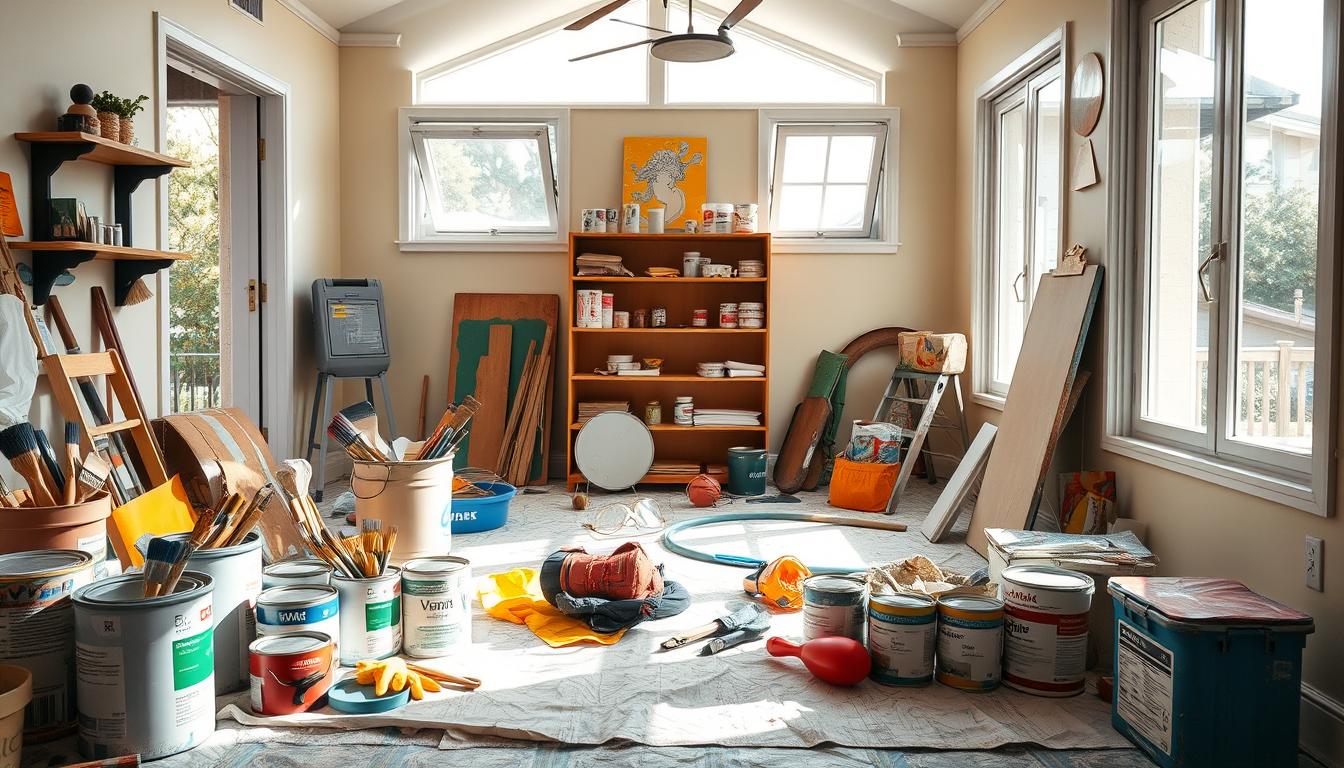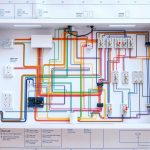safety is paramount. Paint safety is vital to avoid health risks and ensure a safe workspace. By adhering to paint safety guidelines, you safeguard yourself and your environment from potential dangers. Safe painting practices are crucial for maintaining a healthy and secure environment.
Recognizing the significance of paint safety and taking the right precautions can greatly enhance your health protection. This guide offers essential information on paint safety, safe painting practices, and health protection. It is designed for both professional painters and DIY enthusiasts, aiming to educate on the risks of painting and how to mitigate them.
Introduction to Paint Safety
Paint safety transcends mere protective gear; it encompasses creating a secure environment for all. By selecting the appropriate paint, ensuring proper ventilation, and adhering to safety protocols, you can guarantee a safe and healthy painting experience. This guide delves into paint safety fundamentals, including the hazards linked to various paint types and the critical role of ventilation.
Key Takeaways
- Paint safety is essential for protecting yourself and your space
- Safe painting practices can prevent health risks and ensure a safe working environment
- Proper ventilation is crucial for maintaining a healthy and safe environment
- Choosing the right paint can make a significant difference in paint safety
- Following safety guidelines can minimize risks associated with painting
- Health protection is a critical aspect of paint safety
Understanding Paint Safety Fundamentals
Painting requires prioritizing safety above all else. Paint fumes can pose serious health risks, making proper ventilation crucial. Safety equipment, such as masks and gloves, also plays a key role in reducing exposure to harmful chemicals.
Different paints come with unique safety considerations. For example, oil-based paints have higher VOC levels than water-based paints. Knowing these differences is vital for ensuring a safe painting process.
To maintain a safe painting environment, following key safety measures is essential. This includes using protective gear, ensuring good ventilation, and being mindful of potential hazards like paint fumes. By doing so, you can significantly reduce painting-related risks and create a healthier space for everyone.
Common Paint Safety Hazards
- Paint fumes and VOCs
- Chemical splashes and spills
- Fire hazards from flammable paints and solvents
Why Proper Safety Measures Matter
Implementing proper safety measures is critical to avoid accidents and ensure a safe workspace. By grasping paint safety basics and taking the right precautions, you safeguard yourself and others from potential dangers. This approach fosters a safe and healthy environment for all.
Essential Safety Equipment for Painting Projects
When painting, the right safety equipment is key to protect yourself and your workspace. This includes personal protective equipment (PPE) like gloves, masks, and goggles. Ensuring workspace safety is also vital to prevent accidents and ensure a smooth painting process.
To select the right safety equipment, consider the paint type and potential hazards. For instance, oil-based paint may require a mask with a filter to avoid inhaling fumes. Here are some must-haves for your safety equipment list:
- Gloves to protect your hands from paint and other chemicals
- Masks to prevent inhalation of fumes and particles
- Goggles to protect your eyes from splashes and spills
Always follow the manufacturer’s instructions for your safety equipment and store it properly after use. This ensures your workspace safety is maintained and you’re protected from hazards. By investing in the right PPE and safety equipment, you can have a safe and successful painting experience.
Proper Ventilation Requirements for Safe Painting
When painting, ventilation requirements are key to a safe workspace. Paint fumes pose health risks, and good ventilation prevents their buildup. Inhaling these fumes can cause respiratory issues and other health problems.
To ensure proper ventilation, you can opt for natural or mechanical methods. Natural ventilation involves opening windows and doors for fresh air. Mechanical ventilation uses fans and air purifiers to remove fumes. Both methods help maintain air quality and prevent harmful fume buildup.
Natural Ventilation Methods
- Open windows and doors to allow fresh air to circulate
- Use cross-ventilation to remove paint fumes from the air
Monitoring Air Quality While Painting
Monitoring air quality while painting is crucial. Use air quality monitors to check paint fume levels. These tools help you know if air quality is poor and need improvement.
By adhering to ventilation requirements and using natural or mechanical methods, you ensure a safe workspace. Remember, health protection is paramount when painting. Proper ventilation is essential for maintaining air quality.
| Ventilation Method | Effectiveness |
|---|---|
| Natural Ventilation | High |
| Mechanical Ventilation | High |
Personal Protective Equipment (PPE) Selection
Ensuring workspace safety is paramount, and the right Personal Protective Equipment (PPE) is key for painting tasks. PPE serves as a shield, protecting painters from hazards and preventing injuries and illnesses. With a variety of PPE options, choosing the correct gear is vital for a secure work environment.
First, assess the safety equipment needed for your project. Consider the paint type, workspace ventilation, and potential risks. This evaluation helps determine necessary PPE, like respiratory gear, protective clothing, and eye and hand protection.
Key PPE Considerations
- Respiratory protection: masks or respirators to prevent inhalation of paint fumes and particles
- Protective clothing: coveralls, gloves, and safety shoes to prevent skin contact and foot injuries
- Eye and hand protection: goggles, safety glasses, and gloves to prevent eye and hand injuries
By choosing the right PPE and using it properly, painters can reduce risks in painting projects. Remember, workspace safety is a top priority. Investing in proper PPE is crucial for protecting yourself and others on the job.
Preparing Your Workspace for Safe Painting
When painting, workspace safety is paramount to avoid accidents and guarantee a successful outcome. Before starting, clear the area of clutter and cover surfaces with drop cloths. This step prevents damage to furniture and floors and minimizes tripping hazards.
To uphold paint safety, employing safety equipment like ladders and step stools is crucial. Always adhere to the manufacturer’s guidelines and exercise caution to prevent accidents. Here are some key tips to remember:
- Always inspect the ladder or step stool before use
- Make sure the ladder is placed on a firm, level surface
- Never lean over the side of the ladder to reach for something
Good lighting and ventilation are also vital for a safe and efficient workspace. Open windows and doors for proper ventilation. Use lamps or overhead lighting to illuminate the area. By following these guidelines, you can create a safe and comfortable environment for your painting project.
Remember, workspace safety is as critical as the quality of your paint job. By preparing your workspace and using the correct safety equipment, you can ensure a successful and accident-free painting project. Always prioritize paint safety to safeguard yourself and your space.
Safe Paint Storage and Handling Techniques
Proper paint storage and handling are key to paint safety and accident prevention. When storing paint, temperature control is vital to avoid spoilage or hazards. The ideal storage temperature ranges from 60°F to 80°F (15°C to 27°C).
Adhering to chemical storage best practices is also essential for a safe environment. Paints and chemicals should be stored in a well-ventilated area, away from sunlight and heat. Here are some tips for safe storage:
- Store paint in a cool, dry place
- Keep paint away from children and pets
- Use proper labeling and signage to identify stored chemicals
Proper disposal methods are critical for maintaining safe storage and preventing environmental hazards. Leftover paint and hazardous materials must be disposed of according to local regulations. Below is a summary of proper disposal methods:
| Material | Disposal Method |
|---|---|
| Latex paint | Dispose of in regular trash |
| Oil-based paint | Take to a hazardous waste collection facility |
| Chemical containers | Recycle or dispose of according to local regulations |
By adhering to these guidelines and considering chemical storage best practices, individuals can ensure a safe environment. Always prioritize paint safety when handling paint and chemicals.
Emergency Response and First Aid for Paint-Related Incidents
Working with paint demands readiness for emergencies and a well-thought-out plan. Emergency response is paramount in paint-related incidents, like spills or fires. Basic first aid knowledge can avert minor issues from escalating.
To maintain paint safety, adhering to protocols and utilizing safety gear is essential. Here are preventive measures for emergencies:
- Always read the label and follow instructions on the paint can
- Use protective gear, such as gloves and masks
- Ensure good ventilation in the workspace
- Keep a fire extinguisher nearby
In emergency situations, remain calm and adhere to emergency response guidelines. For minor incidents, like skin or eye irritation, treat the area with water. Seek medical help if the issue persists.
Remember, paint safety is a collective responsibility. Preparation and adherence to protocols can significantly reduce the risk of paint-related incidents. This ensures a safe working environment for all.
| Incident | Response |
|---|---|
| Paint spill | Contain the spill, ventilate the area, and clean up carefully |
| Fire | Evacuate the area, call the fire department, and use a fire extinguisher if safe to do so |
| Skin or eye irritation | Flush the affected area with water and seek medical attention if necessary |
Special Considerations for Different Painting Environments
Different painting environments demand unique safety protocols. Whether indoors, outdoors, or in industrial settings, specific safety risks must be addressed. It’s crucial to take necessary precautions to ensure safety.
Indoor Painting Safety Protocols
Indoor painting environments require careful attention to ventilation and lighting. Proper ventilation is essential to prevent fume and particle buildup. Specialized safety equipment, like respirators and protective clothing, may also be necessary.
Outdoor Painting Precautions
Outdoor painting environments come with their own set of safety risks. These include exposure to the elements and potential hazards from nearby structures. Following safety protocols, such as using scaffolding and fall protection, is vital for a safe working environment.
Industrial Painting Safety Requirements
Industrial painting environments necessitate strict adherence to safety protocols. This includes the use of specialized safety equipment and protective gear. Industrial painting often involves hazardous materials. It’s critical to follow safety regulations and guidelines to prevent accidents and ensure a safe working environment.
By considering the unique safety risks and protocols for different painting environments, you can ensure a safe and successful painting project. Always follow safety guidelines and regulations. Take necessary precautions to protect yourself and others in the painting environment.
Conclusion: Making Safety Your Painting Priority
As we wrap up this paint safety guide, it’s evident that safety must be a top concern for any painting project. This applies to both residential, commercial, and industrial settings. The health and safety of the painter and those nearby are paramount.
In this guide, we’ve delved into the critical safety measures needed for a safe painting experience. We’ve covered understanding common paint safety hazards and choosing the right personal protective equipment (PPE). The goal is to always approach painting with a focus on safe painting practices.
It’s important to remember that proper workspace preparation, maintaining good ventilation, and following safe handling and storage guidelines are key. These steps can significantly reduce the risk of accidents and protect your health. By prioritizing safety, you can confidently undertake painting projects, knowing you’ve taken the necessary steps to protect yourself and your environment.


